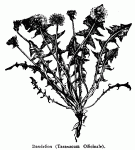Dandelion. Taraxacum officinale Weber. (A).
 SYNONYMS—Taraxacum taraxacum (L.) Karst: (a) Taraxacum densleonis Desf.
SYNONYMS—Taraxacum taraxacum (L.) Karst: (a) Taraxacum densleonis Desf.
DRUG NAME—Taraxacum.
OTHER COMMON NAMES—Blow-ball, cankerwort, doonhead, clock, fortune-teller, horse gowan, Irish daisy, yellow gowan, one-o'clock.
HABITAT AND RANGE—With the exception, possibly, of a few localities in the South, the dandelion is at home almost everywhere in the United States, being a familiar weed in meadows and waste places, and especially in lawns. It has been naturalized in this country from Europe and is distributed as a weed in all civilized parts of the world.
DESCRIPTION OF PLANT—It is hardly necessary to give a description of the dandelion, as almost every one is familiar with the coarsely toothed, smooth, shining green leaves, the golden-yellow flowers which open in the morning and only in fair weather, and the round fluffy seed heads of this only too plentiful weed of the lawns. In spring the young, tender leaves are much sought after by the colored market women about Washington, who collect them by the basketful and sell them for greens and salad.
Dandelion is a perennial belonging to the chicory family (Cichoriaceae) and is in flower practically throughout the year. The entire plant contains a white milky juice.
DESCRIPTION OF ROOT—The dandelion has a large, thick and fleshy taproot, sometimes measuring 20 inches in length. In commerce, dandelion root is usually found in pieces 3 to 6 inches long, dark brown on the outside and strongly wrinkled lengthwise. It breaks with a short fracture and shows the thick whitish bark marked with circles of milk ducts and a thin woody center, which is yellow and porous. It is practically without odor and has a bitter taste.
COLLECTIONS AND USES—Late in summer and in fall the milky juice becomes thicker and the bitterness increases and this is the time to collect dandelion root. It should be carefully washed and thoroughly dried. Dandelion roots lose considerably in drying, weighing less than half as much as the fresh roots. The dried root should not be kept too long, as drying diminishes its medicinal activity. It is official in the United States Pharmacopoeia.
Dandelion is used as a tonic in diseases of the liver and in dyspepsia.
IMPORTS AND PRICES—Most of the dandelion root found on the market is collected in central Europe. There has been an unusually large demand for dandelion root during the season of 1907 and according to the weekly records contained in "the Oil, Paint and Drug Reporter" the imports entered at the port of New York from January 1, 1907, to the end of May amounted to about 47,000 pounds. The price ranges from 4 to 10 cents a pound.
Ginseng and Other Medicinal Plants, 1936, was written by A. R. Harding.

